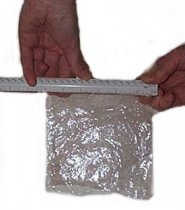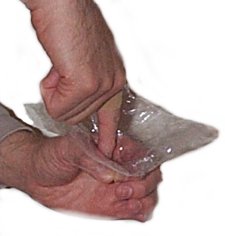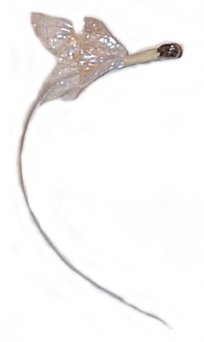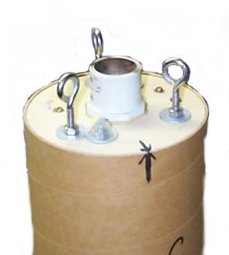Ejection Charge Construction
 |
Ejection canisters
Ejection charge canisters for small to moderate sized airframes can be easily and quickly constructed. Most materials can be purchased from home improvement and hardware stores, with the exception of the electric matches.These canisters use a low current electric match (Daveyfire or Oxral) to ignite the ejection charge, not a photography flashbulb. Electric matches are more reliable and vary less from batch-to-batch than flashbulbs. But even electric matches should be tested with a continuity tester prior to use.
Redundancy in the recovery ejection system can help prevent property and personal injury. A more reliable recovery system can be built by using dual electric matches per canister. Both matches can be connected to the same electronic controller, or each electric match can be connected to separate controllers. If the rocket design allows for redundant ejection charges, then a single match per canister can be used, with each canister wired to a different electronic controller.

|
The materials needed to build the canisters are shown here and listed below.
- Hot glue gun
- Polyethylene tubing (1/2" outside diameter, 3/8" inside diameter)
- Knife to cut the polyethylene tubing
- Electric matches
An advantage of translucent polyethylene tubing over cardboard tubing for the canister is that the placement of the electric match and black powder can be seen to ensure that the matches are not buried in glue, and that the black powder covers the matches and is sealed in by a masking tape cap.
Construction Steps

|
If the canister will use a single match insert the match into one
end of the tube about 3/8", and add hot glue.
You want about 1/4" of glue in the tube under the match's head,
and position the head to just be above the glue. If a little glue gets on the
match's head the match will blow it off when it fires.
Hold the tube until the glue cools enough that it no longer runs.
you may need to rotate the tube to keep the glue evenly distributed.

|
Materials to prepare the canisters for flight are listed below.
- Masking tape, 3/4" or 1" wide, cut into 1" long lengths (one per canister)
- A pen with a rounded end or other object that fits into the tube
- Black powder and measuring cup
Steps to prepare a canister for use are listed below.
Measure the amount of black power needed for the ejection charge
and pour into the canister.

|
Push the tape into the tube down to the black powder to create a cap that keeps the powder in the canister.
The canister is ready to be used.
| Questions | Answers |
|---|---|
| Q: The match head is partially buried in the glue. Can the canister be used? | A: Yes, the match will still ignite the black powder provided the exposed match head is in contact with the black powder. |
| Q: When I add the black powder the match head is above the powder. | A: The canister cannot be used. The masking tape used to keep the powder in the tube may prevent the match from igniting the powder. |
| Q: Isn't using two electric matches per canister a waste of money? | A: If we lived in a perfect world where everything always worked as desired, yes, it would be. But our reality is not perfect. Electric matches can fail. Electronic recovery system controllers can fail. The author believes it is better to error on the safe side. Perhaps one match per flight will be wasted because the other one will always work. However, that's a better situation than having a rocket smack into the ground, person or car because a charge failed to fire. |
Plastic Wrap Charges
Large and small ejection charges can be quickly and cheaply constructed from common household materials.
 Materials
Materials
- Plastic wrap - whatever brand you have
- Low current electric igniter. Pictured here is a Daveyfire N28B.
- Masking tape
- Black powder
Procedure

- The plastic wrap is 12" wide. Pull out and cut off a 12" long piece.
- Fold in each direction so that you now have a 6" square.

- Form an "oh" with a thumb and finger. Lay the square over
it
and press in with a finger to create a well.
 Black powder and
an igniter will be placed into the well.
Black powder and
an igniter will be placed into the well.
- Pour black powder into the well.
- Insert an igniter.
- Twist the plastic wrap around the igniter and wrap with masking tape. Excess plastic wrap can be cut off.
 A finished ejection charge. Excess plastic wrap has not been cut off
yet.
A finished ejection charge. Excess plastic wrap has not been cut off
yet.
In the top right corner is the black powder and igniter. Masking tape is wrapped just in back of the black powder to create a seal.
The author encourages the use of two igniters per charge. Though the
probability of a commercially manufactured electrical igniter failing
is low, the use of two igniters per charge further reduces the chance
of personal injury or property damage from a recovery system failure.
 An ejection charge can make the inside of an airframe dirty. The soot
can
be contained. In this photo is one idea. A PVC pipe fitting is attached
to the top of
the electronics bay. The ejection charge is placed into the fitting.
An ejection charge can make the inside of an airframe dirty. The soot
can
be contained. In this photo is one idea. A PVC pipe fitting is attached
to the top of
the electronics bay. The ejection charge is placed into the fitting.
Submitted by Dean A. Roth
